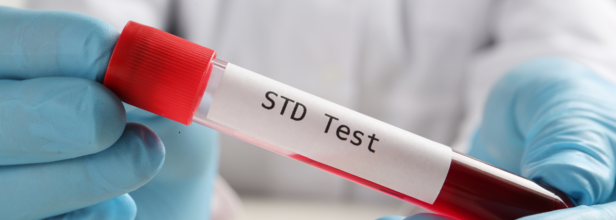
Credits: Canva
STI and STD Are Not The Same Thing, Know Why
Did you know that STIs and STDs are not the same thing?
While we often use the words interchangeably, they are not the same health concerns, though both happen due to sexually transmitted bacteria through bodily fluids. If you do not know the difference, do not worry, here's all that you need to know.
STIs are sexually transmitted infections, whereas STDs are sexually transmitted diseases. An STI is only considered a disease when it causes symptoms.
The Difference Between Infection and Disease
The main difference between the two is that an infection marks the beginning of a process where pathogens, like bacteria, viruses, or parasites, enter the body and start multiplying. Infections may not always cause symptoms, making them the silent precursor to diseases.
A disease is when infection damages the body’s cells, and it leads to noticeable signs and symptoms. For sexually transmitted conditions, this distinction is why experts prefer the term STI over STD, as many STIs are asymptomatic and don’t progress to diseases.
All STDs Start as STIs, But Not All STIs Become STDs
STDs begin as an infection, however, only some infections may never cause diseases, like HPV, which clears on its own. When it persists, it may turn into a genital wart or cancer, that is when it transforms into a disease.
ALSO READ: These 10 US States Have The Highest STI Cases
Common Symptoms to Watch For
STIs and STDs manifest differently. Most of it depends on the infection and the type of sexual activity one is involved. Symptoms might not appear immediately or even for years. Key signs include:
- Bumps, sores, or rashes near genitals or anus
- Painful urination or discharge from the penis or vagina
- Unusual vaginal bleeding or pelvic pain
- Swollen lymph nodes or testicles
- Rectal bleeding or itching around the genitals
What Are The Common STIs?
- Herpes (HSV-1 and HSV-2)
- Chlamydia
- Syphilis
- Gonorrhea
- Human papillomavirus (HPV)
- Trichomoniasis
- HIV/AIDS
When to Get Tested
Regular testing is crucial for sexually active individuals. The Centers for Disease Prevention and Control (CDC) recommends yearly screenings, but testing is especially important if you:
- Had unprotected sex
- Have a new or multiple partners
- Are pregnant
Suspect exposure to an STI
Testing too soon might not detect an infection, as STIs have incubation periods ranging from days to months. Consult a healthcare provider for tailored advice on testing timelines or preventive measures like PEP for HIV.
What to Do After Testing
Negative Results: Stay vigilant with routine screenings and discuss preventive strategies with your healthcare provider, like using condoms or starting PrEP for HIV prevention.
Positive Results: Treatment varies by infection. Bacterial STIs are typically treated with antibiotics, while viral STIs require antiviral medications for symptom management. Always notify partners for testing and treatment to prevent further spread.
Are There Any Food That Can Help You Against STI?
- Ginger: used to kill off oral pathogens
- Garlic: contains antiviral, antibacterial, and antifungal properties
- Honey: it contains hydrogen peroxide, methylglyoxal, and peptide bee defensin, and has a low pH and antibacterial properties
- Cabbage: it is a detoxifying food with antibacterial properties
- Horseradish: it is used to treat UTIs
- Coconut Oil: it also has antiviral, antibacterial, and antifungal properties
- Apple cider vinegar: it is known to be an at-home treatment for warts
- Turmeric: it has powerful anti-inflammatory properties and is also an antibacterial
- Cranberry Juice: it has antibacterial properties

(Credit-Canva)
Are ‘Microbreaks’ The Answer To Long Working Hour Fatigue?
Work can often become overwhelming, you have multiple tasks to complete, meet deadlines, make sure your schedule is managed well, and ensure you are punctual. While it might be similar for most corporate employees, not everyone is able to cope with a hectic schedule and taking breaks is a good solution for this.
However, in this competitive world, it can be difficult to take breaks without raising eyebrows, so does that mean you cannot work efficiently? No, but you can try microbreak!
Microbreaks are short, frequent pauses in your day. They help you avoid sitting for too long- these breaks can be less than a minute or up to 10 minutes. The idea is to give your muscles rest, especially when doing repetitive tasks. Such short breaks will help you detach from feeling overwhelmed or stressed short without interrupting your workflow.
How Often Should You Take Breaks Between Work?
Experts recommend taking 2 to 3 minutes break every 20-30 minutes during the day. For better heart health, studies suggest taking a 5-minute break every 30 minutes is recommended. This means 25 minutes of work, followed by 5 minutes of activity. Microbreaks do not have to be always planned out, it can be something as small as taking a stroll from one part of the office to the other. You can also do stretches, breathing exercises or enjoy a light conversation. Here are some benefits of taking microbreaks:
Less Muscle Pain
Short breaks can ease muscle stiffness from sitting. While more studies are needed, I found my chronic shoulder and back pain lessened. Regular movement helps prevent prolonged discomfort.
More Energy
Quick activity breaks can fight fatigue and boost your energy. Active breaks, like walking or stretching, are more effective. I felt a noticeable increase in my energy levels throughout the workday.
Better Focus
Microbreaks improve focus, especially for routine tasks. Complex tasks might require longer breaks. Short pauses refresh the mind, helping you stay alert and productive on less demanding work.
Improved Mental Health
Even brief breaks can lower stress and enhance mental well-being. Taking a few minutes to step away from work helps clear your head and reduces feelings of overwhelm.
How to Make Microbreaks A Daily Habit?
While microbreaks can be beneficial, they could also potentially disrupt workflow, making it hard to pause when deeply focused. Microbreaks may also lead to refocusing challenges, especially for those who have difficulties with attention. Plus, fitting them into your busy schedule, particularly with meetings, can be problematic.
To make microbreaks a regular habit, set reminders and keep things interesting by varying your activities. Create an activity list, choosing breaks that match how you feel at the moment. Try to stick to your schedule but be flexible; missing a break occasionally is okay, just keep trying. This could be a great new addition to your workspace and help you find new momentum.

(Credit-Canva)
Are You In Love Or Just A Dopamine Rush? What Happens To Your Body When You Are Smitten
Being in love, having somebody you deeply care for or enjoying the company of that special someone can be a great feeling- the elevated feeling of being on cloud nine and the joy it brings people yearning for a healthy and loving relationship. Everyone claims love changes people, and there are many biological bodily changes that take place when you are in love.
Here are some ways love can change the way you are.
It Gives You a Dopamine Rush
When you fall in love, your brain gets flooded with dopamine, a chemical that makes you feel really good. Harvard Health explains that when one is in love, there is a dopamine surge throughout the body, like the pleasure you get from other enjoyable activities. It's the brain's way of rewarding you, making you want to be around that person more.
It Helps You Form Strong Bonds
Oxytocin, often called the "love hormone," helps you form strong connections with others, this hormone gets released when you feel attracted to someone. This hormone plays a big part in building relationships, helping you communicate and create good memories together. It's also important for things like childbirth and sex, strengthening the bond between partners.
It Can Impair Your Judgment
When you're in love, it's hard to see your partner's flaws. Your brain kind of ignores the negative things. Harvard Health explains that love basically deactivates the neural pathways which are responsible for negative emotions. You only see the good stuff, making your partner seem perfect. It's like your brain is wearing rose-colored glasses, focusing only on the positive aspects of the relationship.
It Affects Your Fight-or-Flight Response
That nervous feeling in your stomach, the sweaty hands, and fast heartbeat? That's your body's "fight-or-flight" response. When you fall in love, your body releases adrenaline and norepinephrine. These chemicals make your heart race and give you a burst of energy.
It Affects Your Pain Receptors
A 2010 study published in PLOS One showed that love changes the way your pain response works. In the study they gave people small heat stimulants while they looked at a picture of a loved one. This connection helps reduce physical and emotional pain. It shows how powerful love and physical contact can be, providing comfort and support during difficult times.
It Affects Your Cortisol And Anxiety Levels
Falling in love can also be stressful, experts explain that our body releases more cortisol, which can make you feel anxious. This happens because your brain is dealing with a new and intense situation. It can also cause a drop in serotonin, leading to feelings of uneasiness.
It Can Cause Impaired Decision-Making
Love can make you do things you wouldn't normally do. Strong feelings of love, especially in the initial stages, can indeed impair decision-making by influencing brain chemistry and leading to heightened emotions and reduced cognitive control. This can lead to impulsive and risky behavior, as you're less worried about the consequences.

Nursing Influencer Dies From Amniotic Fluid Embolism During Childbirth- What To Know About The Rare Complication?
Hailey Okula, a 33-year-old Los Angeles emergency room nurse and social media nursing influencer, sadly died on March 29, just minutes after giving birth to her first child by C-section. Popular for sharing her IVF experience and life as a nurse on social media, Hailey's life touched thousands of people. But her celebratory birth was transformed into a tragic loss when she experienced an amniotic fluid embolism (AFE) and suffered cardiac arrest minutes after giving birth to her baby boy, Crew.
Hailey's husband, Matthew, announced the tragic news in a video clip uploaded to her Instagram and TikTok accounts. "She was able to see him for a split second," he remembered in an emotional interview with Fox 11 Los Angeles. "She had a little tear in her eye, and we had a little laugh. Then they said they were just wrapping up, and she'd be with us soon. Then everything changed."
What is Amniotic Fluid Embolism?
Amniotic fluid embolism is a rare but devastating childbirth complication that occurs in an estimated 1 in 40,000 births, reports the Cleveland Clinic and Mayo Clinic. It happens when amniotic fluid, fetal cells, or other fetal tissue enters the mother's circulation—most often during labor or delivery—causing a violent immune response. The response can lead to abrupt cardiovascular collapse, respiratory arrest, and disseminated intravascular coagulation (DIC), a severe blood-clotting disorder.
Although a mother having amniotic fluid in her blood during delivery is usual, AFE is unusual because it's the overreaction of the immune system that results in a crisis. The majority are not detectable until symptoms arise, making it virtually impossible to treat at the early stages.
"AFE occurs abruptly and unpredictably. It's very difficult to treat and needs emergency medical treatment," the Mayo Clinic says.
Risks Factors related to AF
Since amniotic fluid embolism is such a rare occurrence, the exact causes have not been elucidated. Some risk factors, however, have been noted in medical literature:
- Advanced age of the mother (35+ years)
- Placenta problems, like placenta previa or placental abruption
- Preeclampsia or pregnancy-induced high blood pressure
- Medically induced labor
- Excessive amniotic fluid (polyhydramnios)
- Forceful contractions or physical trauma during labor
- Tearing of the uterus or cervix
- Forcedps or vacuum extraction during delivery
In fact, AFE has been known to happen in both vaginal and cesarean births, and in Hailey's situation, it occurred during a C-section. Medical professionals estimate that the breakdown in the placental barrier—either from natural or surgical causes—could enable amniotic fluid to leak into the mother's circulatory system. Once there, it can cause the body's severe inflammatory reaction.
Why Amniotic Fluid Embolism is a Condition Without Warning Signs or a Cure?
Hailey's unexpected cardiac arrest was a shock to her care providers and family. Her case emphasizes the heartless truth of AFE: there's no screening test, no diagnostic testing, and no known method to prevent it. Treatment is strictly limited to emergency management—resuscitation, transfusion, and stabilizing the patient.
Unfortunately, outcomes are often grim. The maternal mortality rate ranges from 40% to 80%, and nearly 50% of deaths occur within the first hour. Survivors may face lifelong complications, including neurological damage due to lack of oxygen during cardiac arrest.
Hailey's husband was abruptly faced with the unimaginable—whether to stay with his wife, now critically ill, or his new son. "Not the choice I imagined that I would make," he said, remembering the moment when he discovered doctors were giving Hailey CPR.
While amniotic fluid embolism is largely fatal for mothers, about 70% of babies are delivered safely if immediate emergency measures are taken. The key factor is time. Medical teams must act within minutes to increase the odds of survival for both mother and baby.
What Causes Amniotic Fluid Embolism?
Amniotic Fluid Embolism (AFE) occurs when amniotic fluid, fetal cells, or other debris enters the mother's bloodstream, triggering a severe allergic-like reaction. This can result in catastrophic heart and lung failure as well as abnormal blood clotting. Although the cause is not yet certain, it has been thought to be due to a failure of the placental barrier, usually secondary to trauma during labor or delivery. Risk factors include advanced maternal age, placental abnormalities, preeclampsia, induced labor, or cesarean section. But AFE is unusual and unavoidable, occurring in about 1 in 40,000 deliveries, and can't be averted or forecast with accuracy.
With Hailey, Crew survived and now stands as the only surviving product of a mom who battled long-term infertility, heroically seeking to deliver him into this world. "We wanted this so badly," wrote Matthew in an impassioned Instagram tribute, reflecting on the IVF struggle shared by the couple. I will never forget the day I collapsed apologizing for how much the [IVF] process would affect her. She looked at me and said, 'We are a team.' That was Hailey. A woman who would do anything for the people she loved.
Hailey Okula's untimely death has shed new light on the risks of AFE—a condition even some doctors are not familiar with because it is so rare. As a public figure and ER nurse, Hailey was well-known for speaking out about awareness of women's health and infertility, openly and honestly sharing her IVF journey with her audience.
With the resources of world-class medical technology, no mother should ever die giving life to new life. Still, complications such as amniotic fluid embolism indicate that childbirth is still dangerous—even for healthy, well-tested pregnancies. With the maternal mortality rate still on the increase in most corners of the globe, we owe it to mothers like Hailey to invest in research, education, and quicker emergency response protocols.
© 2024 Bennett, Coleman & Company Limited

